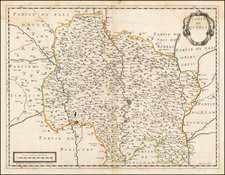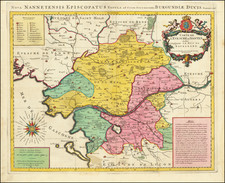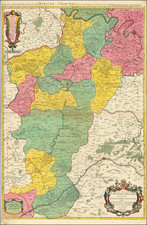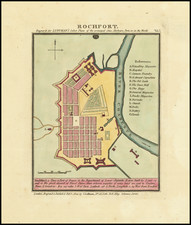Rare map of Poiteau that originally appeared in Maurice Bouguereau's and Jean Leclerc's Le Theatre Francoys, a book considered to be the first national atlas of France.
The map initially introduces the region it shows as "Poictou," and credits the now-lost map of Pierre Roger as its source (although it is, in fact, based on the Ortelius map). It is highly detailed, with many cities and towns named. Forests, rivers, and cities are shown pictorially.
The map is embellished with two title cartouches. The sea is attractively stippled, and the map itself is decoratively presented.
Le Theatre Francoys
This very rare volume is understood to be the first national atlas of France. Published in Tours during the French king's exile from Paris, this work reunites maps of northern and central France.
Many of the maps in the volume are copied from earlier Ortelius and Mercator sources, although some, particularly in the region around Tours, are original maps. These maps would be reused by later authors, including Hondius, Blaeu, and Jansson. All the maps in the text are engraved by Tavernier.
The volume suffered from a lack of spatial completeness, with much of the south of France lacking any coverage. While Bouguereau put a plea for more maps in his introduction, subsequent, more complete editions of this work would not be published until well into the 17th century. The first complete edition would appear in 1642 under the name Theatre Geographique due Royaume de France.
States
This is the first state of the map, with a blank verso indicating a date of circa 1619 (following its first issue in 1594). The title cartouche was later re-engraved with Leclerc's name replacing Bouguereau's.
Jean Le Clerc was an engraver, bookseller and publisher in Paris and Tours.
Le Clerc was baptized on August 16, 1560 in Paris, with the engraver François Desprez (1530–1587) and the painter Jérôme Bollery (1532–1592) as his godfathers. He came from a family of printers and publishers - Jean's younger brother David Le Clerc (1561–1613) and Jean's own son Jean Le Clerc V were both book printers and publishers.
He had proved himself by 1587, at which date he was living and working on Rue Chartière in Paris. For religous reasons, as a Huguenot he fled Paris in 1588 and spent a year elsewhere in France. From 1590 to 1594 he took refuge in Tours, where he worked with the publisher and cartographer Maurice Bouguereau (15??–1596), who created Le Theatre Francoys, the first atlas of France. Le Clerc later worked at several different addresses in Paris - on Rue Saint-Jean-de-Latran until 1610 and then on Rue Saint-Jacques until 1621/24.
Jean Le Clerc's publications included portraits, maps, contemporary news events and other engravings by Jacques Granthomme (1560–1613), Pierre Firens (1580–1636) and Léonard Gaultier (1561–1635). He collaborated with the Dutch printmaker Thomas de Leu (1560–1612) to produce a collection of 179 biblical scenes, allegories, calendar pages and other works, probably published in 1606. They both produced engravings for it themselves as well as using works by Justus Sadeler (1580–1620), Isaac Briot (1585–1670) and Nicolas Briot (1579–1646).
On December 20, 1619 Le Clerc was granted a six-year royal concession to "engrave maps of the provinces of France and portraits of patriarchs and princes of the Hebrew people, with a chronological history". In 1620 he published his Le Théâtre géographique du Royaume de France, including newer plates as well as reworked plates from Bouguereau's work. The new plates were produced by artists such as Jean Fayen (1530–1616), Jodocus Hondius (1563–1612), Salomon Rogiers (1592–1640) and Hugues Picart (1587–1664). It went through several editions and Jean Le Clerc V continued to reissue it after his father's death.














![[Biscaya] De Zeecusten van Vrancrijck en Biscaijen tuschen Arcachon en de C. de Machicaco](https://storage.googleapis.com/raremaps/img/small/84355.jpg)